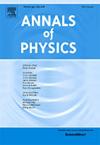Isotropic and anisotropic radiating gravastars with various matter types of thin shell and interior
IF 3
3区 物理与天体物理
Q2 PHYSICS, MULTIDISCIPLINARY
引用次数: 0
Abstract
In this paper, we investigate models of radiating gravastars with both isotropic and anisotropic interiors, incorporating various types of thin shell matter. For the isotropic interior case, we consider a thin spherical shell characterized by an equation of state whose pressure is proportional to its mass density, enclosing a de Sitter spacetime and surrounded by Vaidya exterior spacetime. Our analysis reveals that stable gravastars can form under specific scenarios of radiative mechanisms for certain thin shell matter types. In addition, we briefly discuss the possibility of the existence of stable radiating anti-de Sitter gravastar formation. For the anisotropic interior, we use an anisotropic dark energy model with a Tolman–Matese–Whitman (TMW) mass function. We explore several thin shell matter types: standard, dark energy, and repulsive phantom. Our findings indicate that stable gravastars can emerge in this context, particularly with standard and repulsive phantom thin shells. Furthermore, our results suggest that the density of black holes is consistently higher than that of gravastars and normal stars, regardless of the type of matter in the thin shell. This observation supports the notion that gravastars and black holes are distinct entities, reinforcing the theoretical distinction between these two types of compact objects.
各向同性和各向异性辐射重力星,具有各种物质类型,薄壳和内部
在本文中,我们研究了具有各向同性和各向异性内部的辐射重力星模型,其中包括各种类型的薄壳物质。对于各向同性的内部情况,我们考虑一个薄球壳,其状态方程的特征是压力与质量密度成正比,它包围着一个德西特时空,周围是一个瓦伊迪亚外部时空。我们的分析表明,在特定的辐射机制下,某些薄壳物质类型可以形成稳定的重力星。此外,我们还简要讨论了存在稳定辐射反德西特重力星的可能性。对于各向异性的内部,我们使用具有Tolman-Matese-Whitman (TMW)质量函数的各向异性暗能量模型。我们探讨了几种薄壳物质类型:标准、暗能量和排斥幻相。我们的研究结果表明,稳定的重力星可以在这种情况下出现,特别是具有标准和排斥的虚幻薄壳。此外,我们的研究结果表明,黑洞的密度始终高于引力星和普通恒星,无论其薄壳中的物质类型如何。这一观测结果支持了引力星和黑洞是不同实体的观点,强化了这两种致密天体之间的理论区别。
本文章由计算机程序翻译,如有差异,请以英文原文为准。
求助全文
约1分钟内获得全文
求助全文
来源期刊

Annals of Physics
物理-物理:综合
CiteScore
5.30
自引率
3.30%
发文量
211
审稿时长
47 days
期刊介绍:
Annals of Physics presents original work in all areas of basic theoretic physics research. Ideas are developed and fully explored, and thorough treatment is given to first principles and ultimate applications. Annals of Physics emphasizes clarity and intelligibility in the articles it publishes, thus making them as accessible as possible. Readers familiar with recent developments in the field are provided with sufficient detail and background to follow the arguments and understand their significance.
The Editors of the journal cover all fields of theoretical physics. Articles published in the journal are typically longer than 20 pages.
 求助内容:
求助内容: 应助结果提醒方式:
应助结果提醒方式:


